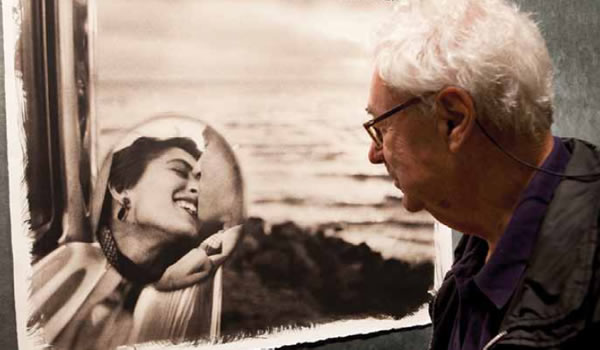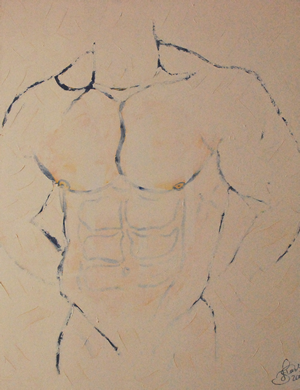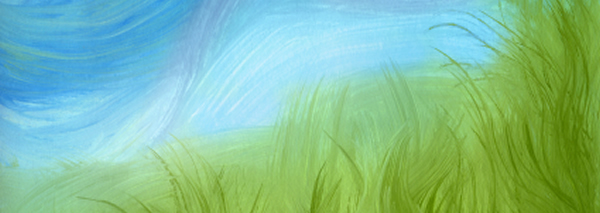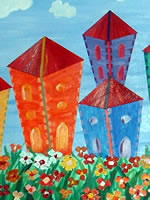Bodybuilder in Pursuit of Perfection – The White North
Painter Predicament: How to Store Acrylic Paints

Finding it difficult to find an inexpensive but effective way to keep your acrylics moist for your next painting session? Here are three ideas for containers to keep your paints fresh and ready for your next visit!
1. Egg cartons: As inexpensive as it gets! Not only does it hold paint, it’s great for mixing. To keep your paints moist, lay a wet paper towel over them before closing the lid.
2. Film cartridge containers: These small, plastic containers keep moisture well and can be securely closed. What’s more, you can stay organized: dab a bit of the colour on the lid so you know what’s in there. Your local photo shop might even save you these containers if you inquire – or at least have some on hand to give over for free when you stop by!
3. Baby food containers: Have a larger amount of paint that an egg carton or film container will hold? Try baby food containers for larger amounts – same great sealing as the film cartridges, but with just that much more space! Ask around friends and family: you’ll soon have more containers than you know what to do with!
Want to add to our list? If you have tips on how to store paint, let us know!
Tips on Watercolours Paintings
A Word on Water Colours
Compared to other art forms, watercolours require little set up and almost no instruction on how to begin using them: add water to the paint, and you’re off! With such a simple procedure, watercolours are an excellent foray into painting for the beginner, or another technical method for the seasoned artist to easily add to their repertoire.
Time and practice are still necessary parts of the equation to acquire proficiency, just as with any other art style or form. However, keep the following tips in mind so that you can approach water colour painting with confidence, and start creating!
Looks Can be Deceiving
When wet, watercolours are dark and vivid; however, when they dry, they dry much, much lighter and paler. This may mean it takes you a while to achieve just exactly the right hue that you want – knowing exactly the amount of water to add is a skill acquired only with practice! If you find your paintings are too pale, add more water to your paint, or add another layer of colour.
Quick as a Wink
Water colours dry very quickly. To avoid frustration, test small samples of colour on scrap paper to see if the dry outcome will achieve the desired hue before you use the paints in your piece.
Dry isn’t Definite
Even when watercolours dry, they are still soluble: applying water to the dry paint will turn it back into wet paint to once again work with. This means mistakes are much easier to fix and changes much easier to make! You can easily remove some paint to achieve a lighter colour, mix it with a new paint for a whole new colour and tone, or even lift the paint entirely off the paper. If you do end up re-wetting dry paint, do be careful to treat the paper gently: scrubbing at the paper too much will damage the surface.
Transparency
Water colours aren’t just pale: they’re transparent. Layers of paint can be seen through upon drying, making mistakes visible. However, don’t be discouraged, embrace it! It is all part of the painting process.
Light à Dark
Any white in watercolour paintings comes not from the paint, but from the white of the paper. This means the usual advice is to paint from light to dark – start with the lightest tones and work towards the darkest. But painting is all about experimentation: you never know what you might create when you put down dark colours earlier than the prescribed method. Shake things up!
Photography: The new Digital Age
Photography is an art form that, with the advent of the digital world, has suddenly become more accessible to the average person: not only do we have digital cameras and photo-enhancing programs such as Photoshop, we also have apps like the iPhone’s Hipstamatic app, which lend a vintage, classic, and aged feel to photos that you snap with your phone. Social media such as Facebook photo albums, Twitter Pics and Pinterest then make sharing a breeze.
In a way, I love that we can do this – the worl d is such an inspiring place that great photos happen all the time; it’s wonderful that technology has advanced to allow us all the ability to take and share photographs easily.
d is such an inspiring place that great photos happen all the time; it’s wonderful that technology has advanced to allow us all the ability to take and share photographs easily.
However, I am still drawn to older, black and white photographs. Where with photographs of nature I like to see the colours represented, when it comes to photographs of people, or of more urban areas, I am much more drawn to black and white photographs. There is something about them that appears more authentic, an honest capturing of a moment – even though I know the photograph is still a highly constructed art form. And I am aware that part of the reason I can enjoy older photographs today is through the internet, which allows me to explore collections from my chair at home, and through digital enhancements, which can recover older photos to truly make them shine to their full potential.
In light of this, I’d like to take a look at two photographs from esteemed photographer, Elliott Erwitt.
The first, “USA. California, 1955”, or more commonly known as “California Kiss”, is famous and beloved around the world. Not only is the content undeniably, heartbreakingly romantic—two figures, caught in a moment of laughter and love in a side-view mirror, by a sea upon which the sun sets, no less— it is also the skill of the photography that has drawn people. The clarity of the image, the attention to detail. It is at once this moment of honesty and spontaneity, and one of construction. The observer can choose to believe in the honesty of the moment – that it really was caught in time, so to speak – or appreciate the construction of it because of what it achieves: a romance, a fantasy, a story.
The next photograph is a favourite: titled “Wilmington, North Carolina”, it is fascinating on a range of levels. Even more than “California Kiss”, this photograph really toes the line between spontaneous and construction: the woman walking by really seems to be caught observing, mid-step, the mannequin observing her. At the same time, the way the photo is taken through the glass, letting some, but not all, of the reflection come in, is highly arranged, and fascinating in that way. The photograph draws the eye to angles and content: the mannequin, by the tilt of the head, seems so real, so believable. The passerby looks at once startled and intrigued by the mannequin: as if she feels the mannequin wistfully looking after her, wanting to get up and walk away, to be human! Or perhaps the woman is thinking how she would like to be the mannequin, to have the flawless face and body. This photograph engages with questions of image, of consumerism, and also fantasy and whimsy. Overall, the photograph achieves a sense of imagination and intimacy.
Oil Paintings: Picasso in Toronto
In just a few short weeks (March 31st, to be exact), tickets go on sale for “Picasso: Masterpieces from the Musee National Picasso” , an exhibition which begins May 1st. That Picasso is coming to the AGO is incredibly exciting: this particular exhibit will have over 150 works that he has handpicked, meaning that there will be pieces from all his different periods: the Blue Period, the Rose Period, the African-Inspired Period, and more.
At Warm Colours, we are so excited to catch this exhibition. In honour of this event in Toronto, I would like to take a look at two particular pieces of Picasso’s that I find incredibly profound. I’m not sure if they will be at the exhibition, but even if they are not, they are worth looking at!

The first one is “The Old Guitarist”, one of his most famed Blue Period oil paintings. Picasso’s Blue Period (1901-1904) was four years in which he primarily painted with only dark colours, shades of blue and greys, with very little use of warmer colours. Working with these colours, Picasso was able to even more deeply explore the dark content and subjects he was portraying: those affected by poverty, the misfits of society, the grim realities of the streets.
“The Old Guitarist” is certainly in keeping with this sober tone: the torn clothing and gaunt complexion of this old man indicate his poverty;
there is no warm light coming from behind him, and his setting looks cold and lonely. His skin looks frighteningly pale, and the attention to his thin frame, from the sinews in his neck to his bony ankles brings chills. However, the painting does more than just depress the observer. While there is a great sense of sorrow, there is also
something oddly inspiring and moving – something about the way that he is wrapped around the guitar, something in the delicacy of his fingers as they glide across the strings: music is his life. This is true in the practical sense of how he may use this to busk in the streets and acquire change for food, but also in a wider sense: it sustains his spirit. The painting speaks to both the sadness in our world, in how art and man are not cherished – but it also speaks to the resiliency of the human spirit when we have art in our lives. Through his guitar, the old man can give voice to his sorrows, to his existence.
The second painting I call your attention to is radically different from “The Old Guitarist”. It is actually the one used in the advertisement for the exhibition at the AGO, Picasso’s “Portrait of Dora Maar” (1937, post-Cubist period). Dora Maar was a Yugoslavian photographer and artist and Picasso’s mistress. I am drawn to this painting – and so am delighted it is being used in advertisement for the exhibition – because of his use of colour and shape. Much has been said of Picasso’s Cubism and his distortion of the human figure, but I am always struck at how Picasso can distort the human figure in a way that it is beautiful – not just that it remains beautiful, but that it almost becomes even more beautiful through the distortion and bold use of unexpected color. While the smallness of the room around the female figure does give a sense of confinement, I am drawn more to the gracefulness in her hand on her cheek, to the small smile that plays on her lips. It is a very loving portrait – perhaps a more quiet vibrancy than some of his other paintings, but vibrancy, delight and love all the same.
If you can, check out the exhibit on Picasso when it comes to Toronto this spring! ? Follow this link http://www.ago.net/picasso-masterpieces-from-the-musee-national-picasso-paris
to learn more about the exhibition, to find out how to purchase tickets, and to learn more about the master himself!
And let me know below: what are some of your favourite Picasso pieces? Does he inspire you?











